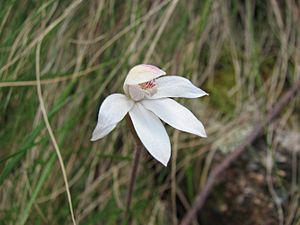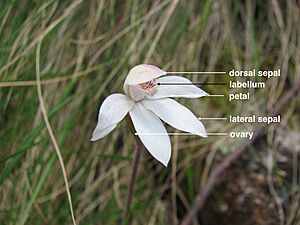Mountain caladenia facts for kids
Quick facts for kids Mountain caladenia |
|
|---|---|
 |
|
| C. alpina in Mount Buffalo National Park | |
| Scientific classification | |
| Genus: |
Caladenia
|
| Species: |
alpina
|
| Synonyms | |
|
|
The Mountain Caladenia (Caladenia alpina) is a beautiful wild flower. It belongs to the orchid family. You can find it growing naturally in cool, high places. These are called subalpine areas. It lives in south-eastern Australia and New Zealand. This orchid has one thick leaf. It also has a tall, thin stem. This stem holds two white flowers. The flowers have cool red stripes on their special lower petal, called a labellum. In New Zealand, people sometimes call this orchid Caladenia lyallii.
What Does the Mountain Caladenia Look Like?
The Mountain Caladenia is a perennial plant. This means it lives for more than two years. It is also a deciduous herb. It has an underground tuber, which is like a storage root. A single leaf grows from this tuber. The leaf is thick and fleshy. It is shaped like a spear. It can be 9 to 28 cm (3.5 to 11 in) long. It is also 5 to 8 mm (0.2 to 0.3 in) wide. The leaf is usually green, but can be dark reddish-green.
The plant usually grows two flowers. Sometimes it has one or three flowers. These flowers grow on a spike, or stem, up to 30 cm (12 in) tall. Each flower is about 40 mm (1.6 in) across. The top sepal (a leaf-like part) is wide and egg-shaped. It is 4 to 8 mm (0.16 to 0.31 in) wide. This sepal curves forward. It forms a hood over the column, which is the central part of the flower.
The other petals and sepals are wide. They are 12 to 20 mm (0.47 to 0.79 in) long. They are white and smooth on the front. On the back, they are pinkish-red to maroon. They also have tiny, glandular hairs. The labellum is the special lower petal. It is about 9 mm (0.35 in) long when flat. It is white with dark red or purple spots and lines. Its edges are wavy. It also has a few short teeth and a pointed tip.
The labellum has four rows of calli. Calli are small, club-shaped bumps. They are yellow or whitish. They get darker and shorter towards the tip of the labellum. The column is about 7 mm (0.28 in) long. It has wide wings and red spots or streaks.
How Did It Get Its Name?
The Mountain Caladenia was first officially described in 1927. A scientist named Richard Sanders Rogers described it. He published his description in a scientific paper. He found the plants on Mount Bogong and Mount Hotham in Victoria. He also found them on Mount Kosciuszko in New South Wales. The scientific name alpina is a Latin word. It means "of high mountains." This name fits because the orchid grows in mountain areas.
In New Zealand, this orchid is often called Caladenia lyallii. Some experts think both C. lyallii and C. alpina grow there. The name lyallii honors a Scottish botanist named David Lyall. He was a friend of Joseph Dalton Hooker. The Royal Botanic Gardens, Kew considers Caladenia alpina to be the same as Caladenia lyallii. Caladenia lyallii was first described by Joseph Dalton Hooker. He wrote about it in his book Flora Novae-Zelandiae.
Where Does It Grow?
The Mountain Caladenia usually grows in subalpine areas. These are places above 1,000 meters (3,300 ft) in height. You can find it in forests and Snow Gum woodlands. It also grows in herbfields, which are grassy areas. Sometimes, it grows near ponds and wet, spongy areas called bogs.
In New South Wales, it grows on the Southern Tablelands. This is south of the Brindabella Range. In Victoria, it grows on the Great Dividing Range and in the Grampians. In New Zealand, Caladenia lyallii grows on both the North and South Islands. It also grows on Stewart Island.


